ABSTRACT
Over the past few years, the Non-Governmental Organizations (NGOs) have helped communities remarkably to respond to and recover from the impact of natural hazards like floods in Pakistan. Compared to the previous natural disasters, 2010 floods were the most devastating and the challenges through relief aid were more significant for the affected families and communities. The purpose of this paper is to gather lesson learned and perception at the community level of the NGOs extended shelter assistance in Khyber Pakhtunkhwa Province. In this regard face-to-face questionnaire was used with 406 respondents (both shelter recipients and non-recipients) for two modules of the questionnaire whilst the 3rd module of the questionnaire was only administered with the shelter-recipients households (HHs) (n=203), using a parallel sampling approach. Overall, the study findings draw attention towards further improvement so that the non-recipients HHs may see and value the assistance as socially balance and integrated. Evidence from this study shows that around 88% of the shelter-recipients expressed their agreement while on the other hand less than one-third of the non-shelter-recipients agreed that the allocation to the recipient’s HHs was based on prioritization of needs and 89% of the shelter-recipient respondents agreed that the given shelters have met their HH accommodation needs. However, among these only 34% fully agreed that it met their accommodation needs adequately whilst 55% only agreed partially however, less than half of them (45%) mentioned should have a boundary wall. Moreover, around one-fifth (20%) mentioned to have at least two rooms and toilets. This paper also offers potential actions for State owned and humanitarian agencies to support long-term sustainability in their relief activities and an often-overlooked element of the disaster recovery cycle. NGOs may be interested in using this document to inform their decision makers about changes to disaster relief policies that better define the components of and organizational roles and responsibilities in long-term recovery to the disaster affected people.
Key words: Shelter Assistance, Khyber Pakhtunkhwa, Flooding, Natural Disaster, NGOs. Pakistan.
Natural hazards are naturally occurring phenomena and worst disasters that cause destructions to human beings and the environment. According to Global Humanitarian Assistance (GHA) report over the last two decades there have been 7,837 natural disasters in over 200 countries and had cost US$1.6 trillion damage and affected 4.4 billion people. The destruction and devastation that natural disasters cause cannot be underestimated. Natural disasters can be ranged in severity and the number of people that are affected can depend on various factors including the density of the population where the disaster occurs, the quality of existing infrastructure, the provision of basic social services and the speed of response (GHA, 2011). Among all natural hazards, flooding is one of the most frequent and widespread of all environmental hazards responsible for 6.8 million deaths in the 20th century. Floods in Asia alone account for nearly 50 percent of fatalities in the last quarter of the 20th century (Doocy et al., 2013). There are different types and magnitudes of floods that occur in most terrestrial portions of the globe, causing huge annual losses in terms of damage and disruption to economic livelihoods, businesses, infrastructure, services and public health.
If we look into the flooding incidents around the world in general, Asia and South east Asian countries in particular, we have found that several countries suffered from severe floods such as the Brahmaputra River in Bangladesh, the Yangtze in China, the Oder and the Vistula in Poland, the Elbe in Germany and Indus in Pakistan (Chowdhury, 2003; Gupta and Sah, 2008; Khan et al., 2009; Wang et al., 2010; Lixin et al., 2012). However, due to its particular geographical and climatological conditions, like other South Asian countries, Pakistan has no exclusion to regular floods which affected millions of people and caused a significant humanitarian disaster with extensive economic and security consequences for the entire country people. There is a long history of disastrous floods in Pakistan (Khan, 2003; Atta-ur-Rahman, 2010) but 2010 floods were the most disastrous floods in the history of the nation (Shah et al., 2017). In the context of flooding history, Pakistan, the 2010 floods were assessed to be the worst since 1929. Extraordinary rainfall occurs between July and September 2010, in the north and north-western regions of the country, particularly Khyber Pakhtunkhwa (KP) Gilgit Baltistan (GB) and Azad Jammu and Kashmir (AJK).
The heavy rainfall caused unprecedented flood peaks in Swat, Kabul and Indus Rivers which affected the entire length of the country. The United Nations (UN) termed the disaster as greater than the 2004 tsunami, the 2005 Pakistan earthquake and the 2010 Haiti earthquake, combined. At the time, National Disaster Management Authority (NDMA) had declared that the floods affected 78 districts and covered over 100,000 sq. km and affected approximately 20 million people (more than one-tenth of Pakistan's population) with over 1,980 reported deaths and nearly 2,946 injured. About 1.6 million homes were destroyed either fully or partially, and thousands of acres of crops and agricultural lands were damaged with major soil erosion happening in the flood affected areas. The 2010 floods were concentrated along main rivers and caused by overflow of river banks and breaches of embankments (NDMA, 2012).
RESPONSE TO THE AFTERMATH 2010 FLOODS
Government Response: In the immediate response mechanism, the government mobilized the national, provincial and district resources including the deployment of civil and armed forces personnel to provide technical support to the national and provincial Disaster Risk Management (DRM) institutions. In this regards small-scale engineering works were undertaken to strengthen flood mitigation infrastructure to avoid further damage and loss of lives. During the peak of the humanitarian crisis, almost 700,000 people were being housed in approximately 3,500 relief camp managed by the government, international partners, NGOs and civil society. The immediate response used to assist the flood affected population was not properly controlled due to lack of resources and other factors; however, the government looked at the international community to tackle the relief challenges in collaboration with the line departments.
International Community Response: The international community immediately rescued and provided relief activities following 2010 floods and have pledged a total commitment of approximately US$ 260 million including support in cash and kind. As of April 2012, approximately, US$ 171 million or 48% were received in response to the UN’s flash appeal.
NGOs and Civil Society Response: The response to 2010 floods by the civil society organizations and the private sector was immediate, rapid and extensive and during relief activities we have seen that many local NGOs acted as the first responders to the disaster and worked extensively with the Government to provide emergency relief support in the affected areas to meet the relied aid challenges including ration packs, water purification kits and tablets, shelter items (including tents, blankets and mosquito nets), sanitation kits and hygiene supplies, doctors and medical supplies, mobile and basic health care units especially for women and children. Individuals and organizations from the private sector, both from Pakistan and the global community have contributed significantly to the flood relief effort alongside the government and donor community.
However, throughout the relief aid activities and process, we have seen a lot of gaps in deliverance of emergency relief services extended to the flood affected people by the Government, International community and NGOs and civil society organizations, which significantly increased the suffering of the people in the affected areas. A consortium of NGOs working in Pakistan reported that there remained nearly one million victims of the 2010 floods monsoons living in makeshift accommodations with no access to aid, with hundreds of thousands of them vulnerable to an impending “public health crisis” (Pakistan Humanitarian Forum, 2011). The failure of NGOs to address the vast crisis in Pakistan truly calls into question their abilities as the cornerstone of global humanitarian aid operations. Edwards and Hulme (1996) advocate for increased attention to the accountability and performance ability of NGOs.
However, the limited nature of this change belies the need for a more drastic improvement to the global modus operandi for disaster management. Zaidi (1999) posits that the solution lies within the state, urging a drastic reform of state welfare programs. However, reliance on the state would be regressive because of the inherent inefficiency of bureaucratization and the irreparably poor reputation of Pakistani government services. An alternative proposal for how to improve the relief operations within the NGO framework will be fielded following consideration of an essential question: why was the humanitarian response so limited?
Objective of the study
1. To assess the perception at the community level regarding the given assistance by drawing a parallel between shelter recipients and non-recipients
2. To provide suggestion and recommendation on the basis of results and findings.
Survey’s area overview/study universe
The study universe includes rural areas of three districts in one region as: Charsadda, Nowshera and Dera Ismail Khan (DIK) District in Khyber Pakhtoonkhwa (KPK) Province (in thirty clusters)
Sample size
The sample size required for this study was estimated to be at least 384 respondents. This estimation was made through EPINFO Statistical Calculator and by incorporating the magnitude of change to be determined, as hypothesis of expected frequency/prevalence of 50%, maximum margin of error or confidence limit of 5% and design effect of 1 for cluster sampling. This sample size is capable of generating reliable estimates of key survey variables at 95% level of confidence with +/- 10% margin of error/precision level for the study universe. This gives a 95% confidence interval with +/- 10% of precision level. Additional 36 HHs (around 10% of the calculated sample size) was added to minimize biases and confounders in cluster sampling and as well non-responses which gave a sample size of 420 to be interviewed across the study universe in 30 clusters with 14 respondents per cluster.
Sample selection procedures
The survey used face-to-face quantitative questionnaire with 406 respondents (both shelter recipients and non-recipients) for two modules of the questionnaire whilst the 3rd module of the questionnaire was only administered with the shelter-recipients HHs (n=203), using a parallel sampling approach.
Questionnaire development
The questionnaire was designed in a way to gather information from both sorts of respondents-those who had received shelters from Non-Governmental Organization (NGOs) and those who did not receive but were living in shelter-recipients neighbourhood. The questionnaire was having three modules covering,
1. Respondent’s HH demographic and socio-economic characteristics,
2. Assistance trends and respondents perception about the given assistance,
3. Occupancy trends and Security of Tenure of the handed over shelters.
The first two modules were asked from both sorts of the respondents while the last module was only administered with shelter-recipients respondents, using parallel sampling approach.
Survey team and field work
The survey team was first practiced interviewing by filling out the questionnaire amongst them, followed by a field-testing. After field-testing, the results of the training and practical field experience were discussed to strengthen further areas of concerns. The interviewers started at the centre point of the pre-selected village/enumeration area by randomly choosing a direction by spinning a bottle or pen on the ground and noted the direction in which it pointed when it stopped. The enumerators walked in the direction to select the households, the interviewers confirmed the pre-defined criteria of selecting an HH and respondents, and interviewed that HH. After interviewing the HH, the enumerators then skipped at least five houses in the vicinity and identified the other intended HH in line with laid down principles of selecting a respondent within the HH.
Data processing, preliminary analysis
The data was compiled in soft, using EPINFO (window version). After handing over of the computed data, 10% of the questionnaires were validated against the data entry. After completing the field work and data management, preliminary analysis was carried out for generating key outcomes and findings of the study. In addition to EPINFO, excel was used to produce graphs.
Respondents’ gender and age characteristics
The respondents’ age and gender characteristics are summarized in Figures 1 and 2. The age of both sorts of respondent’s ranged from 17 to 85 years with a mean of 39.65 years, whereas the age distribution is detailed out in Table 1 for cumulative and shelter recipients/non-recipients.

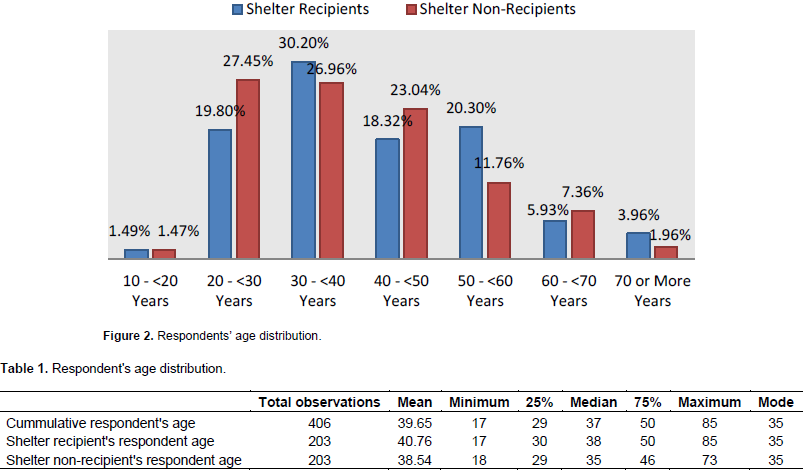
Household’s demographic and residential characteristics
The household size ranged from 2 to 45 members with a mean of 7.34 members per household for both sorts of surveyed respondents, as presented in Table 2 and Figure 3. Concerning the HH residential status, respondents were asked, ‘how would you classify the status of your family by prompting the options with choice of respondents to opt for more than one option’? The responses are shown in Figure 4 which clearly demonstrates similarities at large among both shelter recipients and non-recipients. Moreover, the shelters at large were allocated to the HHs who themselves classify indigenous residents of the area but ‘not EVI’. This raises a concern over the identification and selection process of allocating shelters to the beneficiaries.

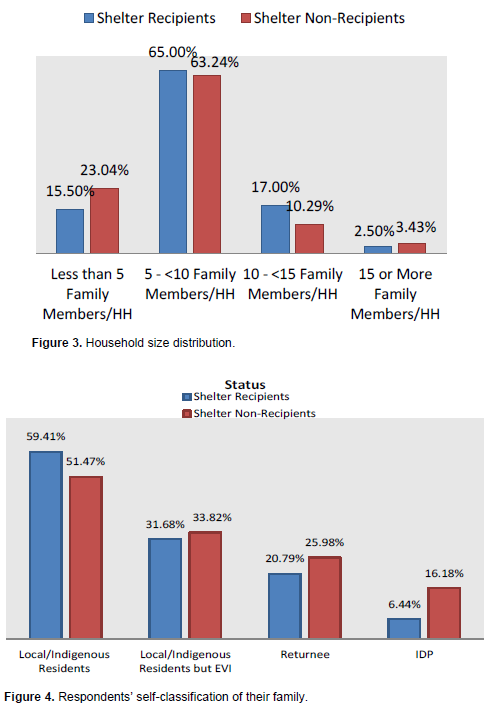
Household’s socio-economic characteristics
Main occupation and working pattern of the HH members
Among the surveyed HHs, at least one member in around two-third instances did any work to earn living. Considering the large family size of an average 7.34 members per household, the HHs has limited opportunities of income generation. Among those who worked, the majority of them worked as farmers followed by the daily labourers. Figures 5 and 6 summarize the frequency distribution of the HH members work pattern and their occupations.
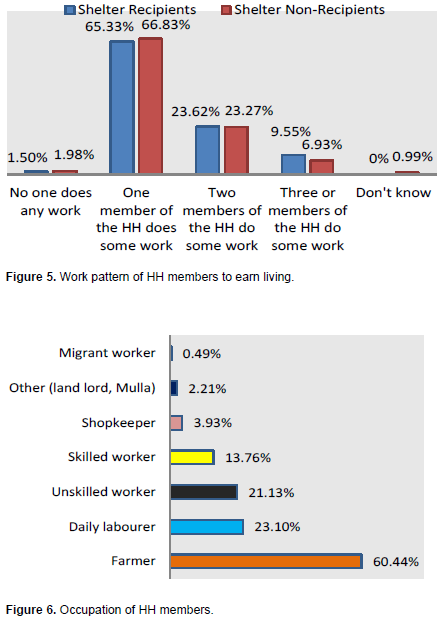
Household income and minimum income requirement to meet HH needs
The economic situation of the survey HHs present a grim picture, as more than two-third of the surveyed HH earn less than 8,000 PKR per month, whereas the vast majority of them stated 15,000 or more PKR as theminimum income requirement to meet their HHs needs and living (Figures 7 and 8). The situation is further compounded by the fact that most of them earn their living as farmers or daily labourers which further signifies the unpredictability of their earning pattern. Upon reflection of the social system, the farmers at large could be the tenants of the land lords and thus gets a considerably low income working as farmers.
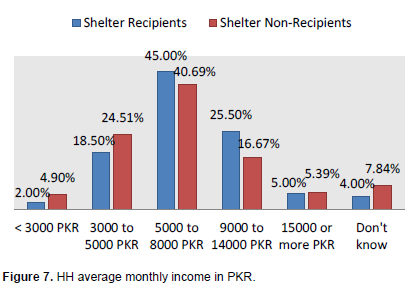
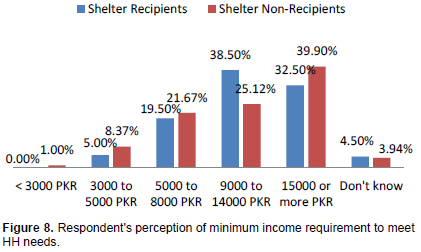
Assistance trends and respondent’s perceptions
Following the assistance trends, both sorts of the respondents were enquired, ‘those who received one-room shelter assistance deserve to receive it using prioritization of assistance on the basis of needs’. The distribution of the respondents’ perception frequencies is presented in Figure 9. Around 87% of the shelter-recipients expressed their agreement while on the other hand less than one-third of the non-shelter-recipients agreed that the allocation to the recipient’s HHs was based on prioritization of needs and align to the eligibility criteria. However, more than half (56.66%) of the non-shelter-recipients avoided sharing their opinion on allocation of shelters to the recipients HHs. Those who disagreed (52 respondents out of 406) are more than half; they stated, ‘there were more deserving families than those who were allocated the shelters’. The frequency distribution of the various reasons why they disagree is shown in Figure 10. Once probed about any marginalized groups that were excluded from allocation, almost all of them could not state any such group. The varying opinions and a clear divide among recipients and non-recipients HHs point towards taking of stringent measures of adequate community mobilization and involvement in allocation of shelters or distribution of in-kind assistance for ensuring transparency.
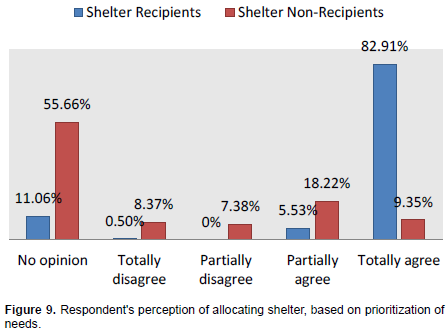

Shelter-recipients’ perception about the given assistance
Around 80% of the shelter-recipient respondents agreed that the given shelters have met their HH accommodation needs. However, among these only 34% fully agreed that it met their accommodation needs adequately whilst 55% only agreed partially, as shown in Figure 11. Among those who disagree or partially agree (n=118 out of 203), they stated additional requirements, as depicted in Figure 12, would have provided and met their HH needs adequately. Less than half of them mentioned having a boundary wall and while the other one-third also stated having a veranda alongside the one-room-shelter. The boundary wall and veranda signifies the traditional elements within the house for ensuring “PURDAH—culturally adequate privacy” while veranda provides a living space for families to sit in or use it for their other HH requirements or social events. Moreover, around one-fifth (20%) mentioned having at least two rooms and toilets.
The varying opinions and a clear divide among recipients and non-recipients households point towards taking of stringent measures of adequate community mobilization and involvement in allocation of shelters or distribution of in-kind assistance for ensuring transparency, using strictly the eligibility criteria and diversification of assistance to the intended beneficiaries. In this regard, NGOs may consider the following:
1. Establishing a village steering committee for identification of programme intended beneficiaries and validate through various means the identification by involving the intended community at large through “village broad based meetings”
2. Strengthening further complaint and feedback mechanisms including displaying of information in the community (through village boards) about eligibility criteria and selection of HHs based on prioritization of needs
3. Refine further the eligibility and vulnerability criteria in consultation with community. This study also highlights the ranking of the used vulnerability criteria which may need to be refine further in the specific context/location where NGOs may intervene in future.
The authors have not declared any conflicts of interest.
REFERENCES
|
Atta-ur-Rahman (2010). Disaster risk management: flood perspective. VDM Verlag, Germany.
|
|
|
|
Chowdhury MR (2003). The impact of 'Greater Dhaka Flood Protection Project' (GDFPP) on local living environment—the attitude of the floodplain residents. Nat. Hazards 29:309-324
Crossref
|
|
|
|
|
Doocy S, Daniels A, Murray S, Kirsch TD (2013). The Human Impact of Floods: a Historical Review of Events 1980-2009 and Systematic Literature Review. PLoS Currents, 5, ecurrents.dis.f4deb457904936b07c09daa98ee8171a. h
Crossref
|
|
|
|
|
Edwards M, Hulme D (1996). Beyond the magic bullet: NGO performance and accountability in the post-cold war world. Kumarian Press.
|
|
|
|
|
Global Humanitarian Assistance Report (2011). Pooled funding mechanisms and large-scale disasters; Case studies of Haiti and Pakistan. Development Initiatives, Keward Court, Jocelyn Drive, Wells, Somerset, BA5 1DB, UK.
|
|
|
|
|
Gupta V, Sah MP (2008). Impact of the trans-Himalayan landslide lake outburst flood (LLOF) in the Satluj catchment, Himachal Pradesh, India. Nat. Hazards 45:379-390
Crossref
|
|
|
|
|
Khan B, Iqbal MJ, Yosufzal MAK (2009) Flood risk assessment of river Indus of Pakistan. Arab J. Geosci. 4:115–122
Crossref
|
|
|
|
|
Khan FK (2003) Geography of Pakistan: population, economy and environment. Oxford university press, Karachi
|
|
|
|
|
Lixin Y, Lingling G, Dong Z, Junxue Z, Zhanwu G (2012) An analysis on disasters management system in China. Nat. Hazards 60:295-309
Crossref
|
|
|
|
|
NDMA: Damages Monsoon 2011 (Sindh and Balochistan), January 16, 2012.
|
|
|
|
|
Shah AA, Ye J, Abid M, Ullah R (2017) Determinants of flood risk mitigation strategies at household level: a case of Khyber Pakhtunkhwa (KP) province, Pakistan. Nat. Hazards 88: 415-430.
Crossref
|
|
|
|
|
Wang X, Yau MK, Nagarajan B, Fillion L (2010). The impact of assimilating radar-estimated rain rates on simulation of precipitation in the 17–18 July 1996 Chicago floods. Adv. Atmos. Sci. 27(2):195-210
Crossref
|
|
|
|
|
Zaidi SA (1999). NGO failure and the need to bring back the state. Journal of International Development. J. Int. Dev. 11(2):259-271.
Crossref
|
|